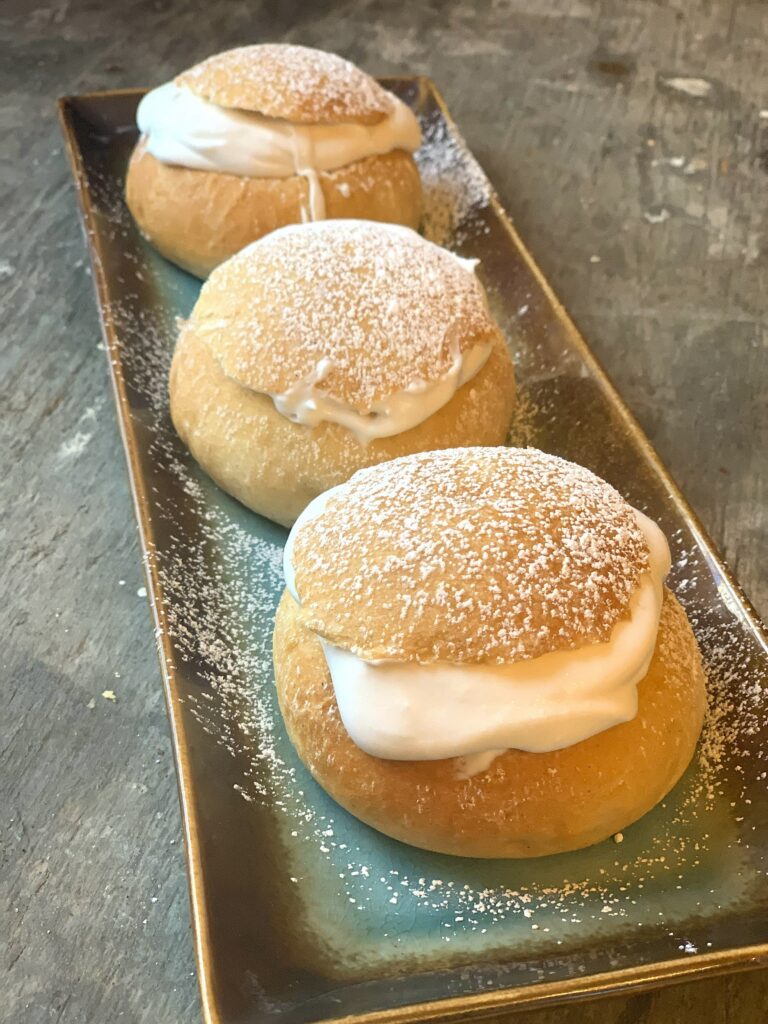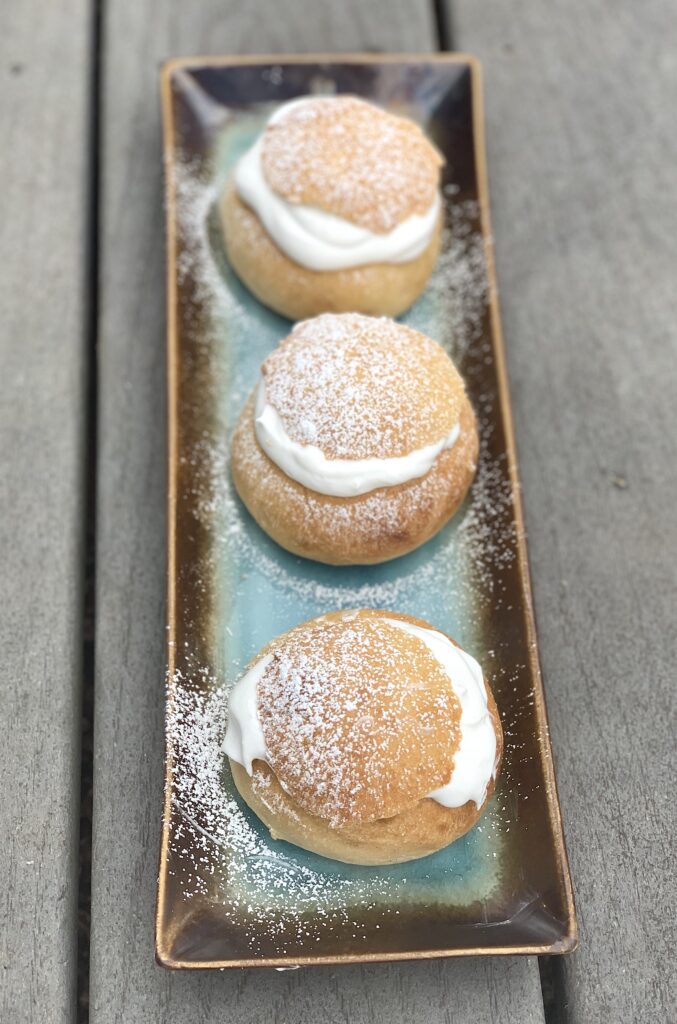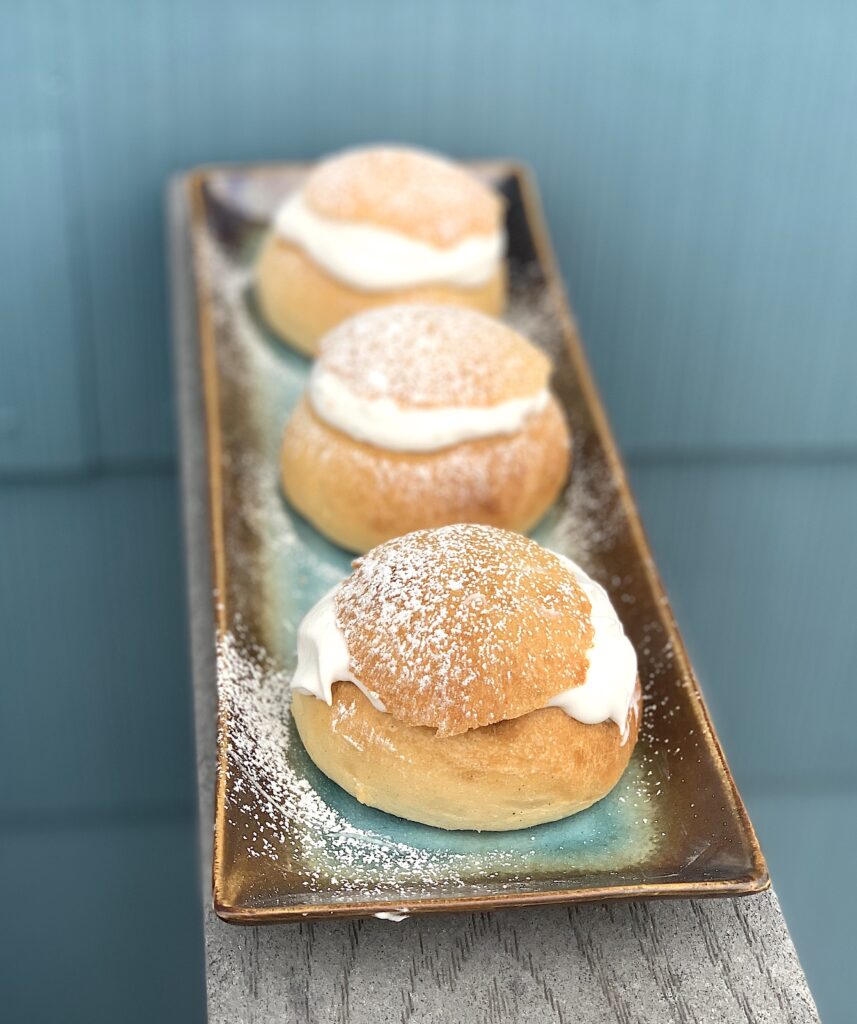This post is re-purposed from a previous entry I made back in 2014. I’ve updated the recipe to be 100% plant-based and 100% equally delicious.
Fastelavn is celebrated the Sunday before Ash Wednesday and evolved from the Roman Catholic tradition of celebrating the days before Lent. Often referred to as the Nordic Halloween, children will dress up in costumes and gather treats for the fastelavn feast. Although we don’t see as much of this tradition in Norway, it’s still practiced in Denmark, who I think are the masters of fastelavn and are known for parades and festivities across the country.
The term fastelavn comes from the old Danish fastelaghen, which again is borrowed from the German word vastel-avent, or fasten abend, meaning “fast evening”. Much like Fat Tuesday (or Mardi Gras) in this country, the day was created to ‘fatten up’ before the fast. In Norway, this Tuesday is often referred to as “white Tuesday”, when white food like flour and milk products were on the menu. In fact, fastelavn is not only one day, but three; fastelavn Sunday, Blue Monday and Fat Tuesday.
Originally a pagan spring fest, fastelavn, is related to many old customs, among others the fastelavnsris; a bouquet of birch branches, often decorated with colorful feathers or candy among other items.
The story goes that women, animals and trees were to be woken up to fertility by being whipped with these birch branches. It was practiced specifically on young married women with no children. A lot of superstition surrounded the birch; which was filled with sprigs full of life this time of year, hence the branch was often called “the life branch”. People believed that birch which not yet had leaves had true fertility power, and the sprigs which developed was a sign of life to come.

Gluttony was the key word for fastelavn. One custom was to eat nine times in every corner of the living room; that totals 36 times! Food included bacon, fatty soups and flour buns. These flour buns were probably the origin of what Scandinavians make and eat surrounding this day, and what is called fastelavensboller; in Norway and Denmark a sweet bun filled with whipped cream and jam.
In Sweden, you have the delicious “semla” or “semlor”, a very similar creation. The difference is the Swedes stuff the inside of the buns with marzipan, something I’ve tried for this recipe. You can access my traditional recipe for Norwegian fastelavnboller here.
Historically, only wealthy people living in big cities made fastelavnsboller and fastelavn didn’t become a nationwide tradition until the 20th century. There are endless variations of recipes of course, but the commonality of the fastelavnsboller is that they contain whipped cream and many are dusted with confectioner’s sugar while some may be topped with chocolate.
I find it interesting comparing the different buns, or cream puffs, among the three Scandinavian countries, Norway, Sweden and Denmark. They are very different in many ways although they may look similar. Norwegians prefer theirs quite simple, with a little bit of sweetened whipped cream and a dusting of confectioner’s sugar, perhaps some raspberry or strawberry jam in the middle.
The Swedes will scoop their buns out, making room for more filling, and sometimes mix the scooped out center with a little marzipan and milk and place it back in the center of the bun. The Danes will use a wienerbrød base to make their buns (I will write about winerbrød and include a recipe in a later post). The buns are often filled with either a chocolate or vanilla custard and whipped cream mixed with some raspberry jam and often glazed with chocolate as well.
I hope you will enjoy my Swedish version today – a bit more decadent perhaps but also fun to experiment with. I used a store-bough marzipan from Odense, which is readily available all across the United States in grocery stores. If you’re the ambitious type, you can of course make your own marzipan – feel free to refer to this recipe for that.
If you don’t want the marzipan filling, you can simply skip that step, and just make the cardamom buns and top with coconut whipped cream. Either way, you are in for a treat!
___________________________________
VEGAN SEMLOR
For the cardamom buns:
900 grams all-purpose flour
150 grams granulated sugar
2 ¼ tsp dry active yeast
1 tsp ground cardamom
¼ cup applesauce
½ tsp salt
5 dl plant-based milk
150 grams vegan butter, diced
Melted vegan butter for brushing the top of the buns
Confectioner’s sugar for decorating and sprinkling on buns
For marzipan filling:
100 grams marzipan (I use the Odense brand)
2-3 tbsp plant based milk
Crumbs from scooping out the inside of the buns
For whipped cream topping:
1 x 14.5 oz (428 ml) can organic full fat coconut milk (I recommend Thai Kitchen), top ‘cream’ only
1/2 cup (125ml) confectioner’s sugar
1 tsp vanilla extract or sugar
To make cardamom buns:
Add all the ingredients except for the diced butter in the bowl of a stand mixer, fit with the dough hook and knead for about 10 minutes on low to medium speed. Add in the diced butter and knead for another 10 minutes until the dough releases from the sides of the bowl. Cover the dough with a clean towel or plastic wrap, place in a warm spot of the kitchen and let rise for 60-90 minutes.
Prepare two baking sheets either by greasing them with a little butter or oil or place a silpat sheet onto the trays.
Turn the dough onto a clean work surface dusted with a little flour and divide it into 4 pieces. Divide each of the 4 pieces into 5 pieces and roll them into buns. Place them onto the prepared sheets, cover with a clean towel and let rise again for about 45 minutes.
Preheat the oven to 450 degrees (250 degrees Celsius) Fahrenheit.
Brush the top of the buns with a little melted butter and bake them in the oven for about 10-12 minutes until golden on top. Remove from oven and let cool on a rack while you make the marzipan and whipping cream.
To make marzipan filling:
Grate the marzipan into a bowl and beat with the milk until you have a paste. Add the inside bun crumbs to the paste and mix again. Pipe into hole of the bun, top with whipped cream.
To make whipped cream filling:
Chill the bowl of a stand-mixer by placing it in the freezer for about 1 hour. Once ready to make whipped cream, pull out the can of coconut milk from the fridge, and scoop out the top /hard part only (reserve liquid for later use), whip for a minute, then add the confectioner’s sugar and vanilla extract and whip for another minute until stiff peaks form.
To assemble:
Cut a small lid off the top of the buns, scoop out some of the inside with a spoon and add to the marzipan filling and combine.
Stuff a spoonful of the marzipan filling inside the dug-out hole, then pipe the whipped cream on top, and place the lid on top. Dust with a sprinkle of confectioner’s sugar. Enjoy!






0 Comments